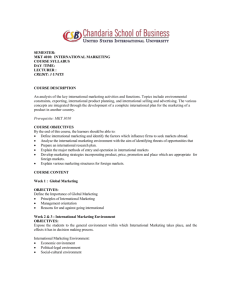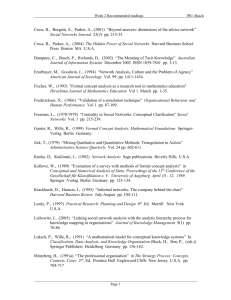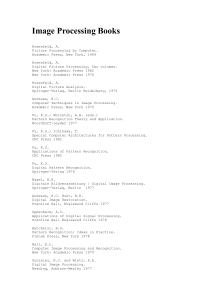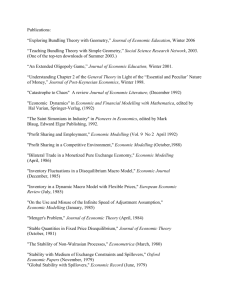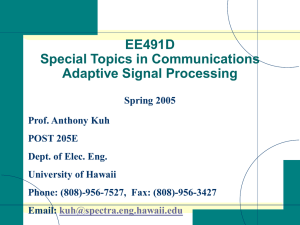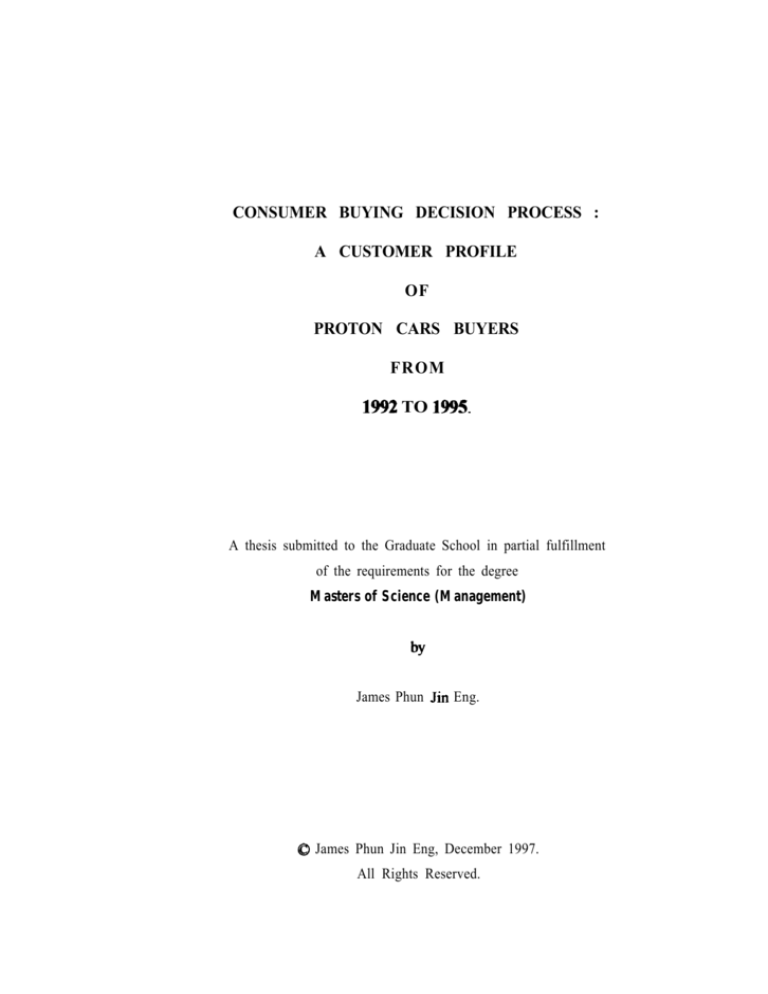
CONSUMER BUYING DECISION PROCESS :
A CUSTOMER PROFILE
OF
PROTON CARS BUYERS
FROM
1992 TO 1995.
A thesis submitted to the Graduate School in partial fulfillment
of the requirements for the degree
Masters of Science (Management)
James Phun Jin Eng.
0 James Phun Jin Eng, December 1997.
All Rights Reserved.
PERMISSION TO USE.
In presenting this thesis in partial fulfillment of the requirements for a Post
Graduate degree from Universiti Utara Malaysia, I agree that the University
Library may make it freely available for inspection
I further agree that
permission for copying of this thesis in any manner, in whole or in part, for
scholarly purposes may be granted by my supervisor(s) or in their absence, by
the Dean of the Graduate School.
It is understood that any copying or
publication or use of this thesis or parts thereof for financial gain shall not be
allowed without my written permission. It is also understood that due
recognition shall be given to me and to Universiti Utara Malaysia for any
scholarly use which may be made of any material from my thesis.
Requests for permission to copy or to make other use of mater& in this
thesis, in whole or in part, should be addressed to:
Dean of the Graduate !W.wol
Universiti Utara Malaysia
06010 UUM smtok
I&dab Darul Aman.
Abstrak.
Pemasamn kereta nasional - Proton yang kini mengwsai pasaran Malaysia bukannya
menjadi suatu perkara luar biasa kerana sikap pengurusan EON yang proaktif terhadap
situasi perniw Dengan pengwmn menyeluruh pasaran ini, maka terdapatnya
satu database makhunat
mengenai pembeli-pembeli kereta Proton yang juga
menunjukkan bahawanya keupayaan pen&p&an masyarakat pembeli kereta Malaysia
yang kim sudah meningkat. Rujukkan awal kepada bahan-bahan kini telah menunjuk
bahawa tidak adanya satu model yang boleh hubung-kait kesehrruhan gelagat pembeli
kepada pembelian tertentu itu. Situasi ini tidak menjadi satu halangan kerana linear
regression model yang diamalltan telah berupaya dan telah member&an suatu Maman
bahawa pengaruh variable-variable gelagat pembeli-pembeli im boleh diukur secara
ranking order. Fakta-fakta gelagat pembeli yang dipanmkan adalah satu manifestasi
mengapa pembeli ini dengan gaya kehidupan (lifestyle) terkini telah dan mampu boleh
memilih dart membeli suatu model Proton tertentu dan bukan yang nyata lebih sesuai
untuknya Kegunaan pakej stastik di dalam komputer peribadi telah pun menolong
pengkajian gelagat pembeli ini dan kept&wan-keputusan tersebut adalah dilampirkan
disini. Penghuraian Bivariate Correlation telahpun menunjukkan bahawa wujudnya
suatu hubungan linear keatas variable-variable pilihanan tersebut. Coefftcient Korelasi
Produk Momen Pearson dapat jelaskan hubuqannya tsdaupw tahimn coefficient
terebut bukannya secara mengeluruh. Walau bagaimana pun, satu gambaran gelagat
pembeli model Proton secara menyeluruh untuk t&m-tahun tersebut tidak dapat
diwujudkan secara amnya, nyata tidak boleh dina&an yang terdapatnya satu jenis
gambaran gelagat pembeli untuk satu-satu model Proton tertentu. Kaedah-kaedah yang
digunakan untuk linear regression model tersebut boleh lagi dihuraikan dart dikemaskan
untuk masa-masa akan datang. hi mesti dirujuk kepada cabamnxabaran industri kereta
tempatan yang akan datang dari segi ‘saturation level’ nya dan peringkatan persaingan di
lantau ini.
11
Abstract.
The market domination of EON in the domestic passenger car market is not
surprising given the company’s management rather proactive reactions and abilities
towards changes in the business enviromnent. This market share has been able to provide
a database of customer information in the determination of this customer profile as it
reflects the rising affluence of the Malaysian car buying population. Various marketing
models were examined to provide some initial manifestation of the subject but not one
single model has sufficiently explanted these purchasing decisions. The present chosen
linear regression model has, however been able to provide an initial understanding that
the intluence of these variables - customer profiles - have a measurable ranking value.
Namely what affects a customer in his decision to purchase a particular Proton model as
distributed by EON. The final invoiced price which is de&Wned by these customer
profiles is thus, a manifestation of these influences. The. presence of powerful stat&&L
pacbes on the personal computers has made significant improvements in the analysis
and the results were tabulated as such. The Bivariate Correlation analysis has indicated a
linear regressed relationship among the variables used and the Pearson PmductMovement Correlation Coefficients can explained sutliciently if not fully the
relationships of these correlation coefficients. A single major customer profIle was not
and could not be determined as there NOW exists different segmented markets for
different Proton models sold This is also perhaps due to the nature of EON’s marketing
practices. This initial limiting understanding was than further examined and a distinct
customer profile was generated for a each particular Proton model as such. This linear
regression model’s forecasting ability can be further developed and refined as need be.
This must be seen against the perceived satumtion level of the domestic car market and
increased market competition in due time.
.. .
111
Acknowledgments
Nomerewordscan~justicertorfullyarad~~y~~thededicated~ortsof
both my advisors cum supervisors towards the completion of this case study. They am
Aaw~&&plr;br~~ ~Abd&Hmd and Dr. .%b~Huscin to whom I
hereby expressed my sincerest and deeply felt gratitude. Their wise and generous counsel
and patient encouragement provided the great& inducement for me to complete this
work and in fact, my graduate studies. Their most kind and able guidance and benevolent
patronage enable me to avoid the research confusion that were purely of my own making.
I would like to take this opportunity to thank my lecturers who am En Ahmad Yacob,
Ak ‘Lany’a c V&& Dr..AniMad,
l?$l.MMunarrwarM~
pit RumA Ahmad, BvK Nti Rug& 13r. Wan Roti, A& Ltv C&w &II,
PO. YmSimHm
andlastbutnotleast, Dr.M~~.
AllofwhomIam
eternally indebted to for the knowledge that they willingly and generously gave to
trandorm and assist me in my quest
I am honor-bound to A& Dot2ald C3a Executive Director of EON, who at one time in
mycareer-enlightenedmeandinsistedthat1
M. Lee Wok Sang,
domomthansellcars
Mr. Danny Wang,
Thisisalsolrueof
En. M& M- and En. Norcv;in
MohdNor who were most supportive of me going back to school.
There is also my outstanding obligation to Cik Sahnah,
Cik Nw Hmaniah, En. A&an of
the~strative~intfK~Schoolwhosek~andlpIwillnotforget.
Last but not least, the dear t&ml, Mr. NgK3oon Sie ancl those not mentioned hem
but whose kindred spirits over the years have made ‘going back to school’ a most worth
while and memorable experience.
MaythegoodLordblessyouall!
iv
Dedication.
Through the most difficult, bitter and unwtain of times, she and she alone, had
stood beside me. Now this is my time to stand by her, my wife and closest
cotidante, Sharon Ong Beoy Choo. The happiest of times, she has shared this
love through my children Stephen, Nicholas and Jennifer Phun.
Permission to Use.. ..................................................................................................
i
Abstract (Bahasa Malaysia) ...................................................................................
ii
Abstract (English) .................................................................................................
iii
Acknowledgments .................................................................................................
iv
Dedication ..............................................................................................................
v
Chapter I :
Introduction . . . . . . . . . . . . . . . . . . . . . . . . . . . . . . . . . . . . . . . . . . . . . . . . . . . . . . . . . . . . . . . . . . . . . . . . . . . . . . . . . . .
1
1.1. Contextofthe Study.. ................................................................................................
3
1.2. Research Objective. ..................................................................................................
4
1.3.
6
Significance of the Study.. ........................................................................................
1.4. Firm’s Characteristics.. .............................................................................................
1.4.1
EON’S OrgaIlizdonal slluctmz.. ...................................................................
.9
9
1.4.2. EON’s Market Practices.. ..............................................................................
13
1.4.3. EONS Market Segmemio Il.. ......................................................................
16
1.4.4. EON’s Sales Procedures . ..............................................................................
18
Chapter II :
Conceptual Framework, . . . . .._......._.........._......................-...... 22
2.0. Literature Review. ..................................................................................................
2.1. Consumer Buying Behavior....................................................................................
2.2. Monadic Models of Consumer Buying Behavior. ................................................
.22
29
.30
The Psychoanalytic Model ............................................................................
30
2.2.2. The ‘Black-Box’ Model ................................................................................
31
2.2.3. ThePerceivedRiskModel ............................................................................
32
2.2.1_
2.2.4.
Summary of the Monadic Models. ...............................................................
vi
34
Page No
2.3. Multi-Variate Models of Consumer Buying Behavior. .......................................
-35
35
2.3.1. The Howard-Ostlund Model. ........................................................................
2.3.2.
The Engel-Kollat-Blackwell (EKB) Model .................................................
2.3.3.
Comparisons made between the Howard-Ostlund and the
.38
Engel-Kollat-Blackwell (EKB) Model. ........................................................
41
2.3.4.
The Nicosia Model. ......................................................................................
.43
2.3.5.
The AndreasanModel. .................................................................................
.46
2.3.6.
Summq of Multi-Variate Models. ............................................................
.48
2.4. Decision-Prm or Logical-Flow Model.. ...........................................................
.49
2.4.1. Criticisms of the Logical-Flow or Decision-Buying Models.. .................... .53
54
2.5. Individual Decision Making. ..................................................................................
2.5.1.
The Optimizing Decision-Making Model. ...................................................
55
2.5.2.
The Satisficing Model. ..................................................................................
57
2.5.3.
The Implicit Favorite Model. ........................................................................
59
2.6. Literature Summary .................................................................................................
61
2.7. Research Model.. ....................................................................................................
-64
2.7.1. TheTransportandRoadResearchLaboratoty(TRRL)Model. ................ .64
2.7.2.
The General Motors Automobile Ownership Theory.. ...............................
.66
2.7.3.
Other Causal Models. ....................................................................................
68
2.7.4. Assumptions of Causal Modeling of Car Ownership. ................................
2.8. DetinitionofTerms
Chapter III :
.7O
72
.................................................................................................
Research Design and Methodology. . . . . . . . . . . . . . . . . . . . . . . . . . . . . . . . 75
3.0. Introduction .............................................................................................................
75
3.1. Delimitation’s and Assumptions of the Study .......................................................
77
3.1.1. Accurateness of Database Records ...............................................................
77
3.1.2.
Consumer Buying Decision Process .............................................................
78
3.1.3.
TheGeogqhicalLocationoftheBranch..
3.1.4.
Completion of Questionnaires .....................................................................
.................................................
3.1.5. TimeDurationofStudyUnde rtaken. ...........................................................
vii
79
.79
80
List of Tables :
Page No
Linear Regression Analysis for 1992 - 1995.
Table 26 : Edited Partial Output of the Models Summary . . . . . . . . . . . . . . . . . . . . . . . . . . . . . . . . . . . . 134
Table 27 : 1992 sllmmaly . . . . . ..._...................._ * . . . . . . . . . . . . . . . . .* . . . . . . . . . . . . ..._..................... 135
E&xl Partial Output of the Linear Regression Analysis
Table 28 : Auto-Correlation.. .................................................................................
138
Table 29 : Hetroscedasticity ...................................................................................
140
................................................................................
143
Table 30 : Multi-Colline&y..
Table31 : Edited Partial Output for 1992 .............................................................
146
Table32 : Model Summary for 1992.. ...................................................................
147
Table33 : Edited Partial Output for 1993 .............................................................
148
Table34 : Model Summary for 1993 .....................................................................
149
Table35 : Edited Partial Output for 1994 .............................................................
150
Table36 : Model Summary for 1994.. ...................................................................
151
Table37 : Edited Partial Output for 1995 .............................................................
152
Table37 : Model Summary for 1995.. ..........................................................
xii
154 - 155
Page No
4.1. Linear Regression Analysis ...................................................................................
4.1.
126
Interpetation of Correlation Analysis.. ................................................................
118
4.1.1.
Final Invoiced Values : BINIVAL.. ...........................................................
118
4.1.2.
Age Comparisons : AGE. ..........................................................................
12 1
4.1.3.
Income Comparisons : INCOME ..............................................................
123
4.1.4.
Literacy (Language Used) Comparisons : LTRCY ..................................
124
4.1.5.
Maritai Status Comparisons : MSTAT ....................................................
125
4.16.
Previous Car Comparisons : PREVC .......................................................
126
4.1.7.
Professionai Status Comparisons : PROF ................................................
127
4.1.8.
Ethnic Status Comparisons : RACE.. ........................................................
128
4.1.9.
Gender Status Comparisons : SEX ...........................................................
129
4.1.10. Hire-Purchase Loans and Period Comparisons : ......................................
130
4.1.11. Quarterly Period Comparisons ..................................................................
132
4.2. Linear Regression Analysis ...................................................................................
133
4.3. Auto-Cordation ...................................................................................................
136
4.3.1.
Decision Rules for AuWorrelation ........................................................
4.4. Hetroscedastcity ...................................................................................................
4.4.1.
White’s Decision Rule for Hetroscdasticity.. ..........................................
4.5. Multi-Collinearity ..................................................................................................
4.5.1.
Decision Rules for Multi-Collinearity ......................................................
137
139
140
141
142
Chapter V : Summary and Conclusions. . . . . . . . . . . . . . . . . . . . . . ..-..._........-................. 144
5.0. Introduction ...........................................................................................................
144
5.1. PredictionAbilityoftheRegressionModel .........................................................
145
5.2. Model Degradation ...............................................................................................
156
5.3. Satumtion Level .....................................................................................................
158
5.4. Conclusion Summary.. ..........................................................................................
159
ix
A.
Notes : @erationame6nitions
B.
Appendices
1.
Internal Orgakation Structure
2.
Vehicle Sales Order (VSO) - Customer Copy
3.
Vehicle Sales Order (VSO) - Sales Branch Copy
4.
Vehicle Delivery Order (VDO) - VDO
5.
Vehicle Invoice (VI) - Customer Copy
6.
Vehicle Invoice (VI) - Sales Branch Copy
7.
Pearson Correlation Coefficients for 1992
8.
Pearson CorrfAation
9.
Pearson Correlation CoefIicients for 1994
Coefficients for 1993
10. Pearson Correlation Coefficients for 1995
c.
BIBLIOGRAPHIES
List of Tables :
Page No
Actual Invoice Sales Breakdown by
: RetailType ..............................................................................................
88
Table 2 : GenderType ............................................................................................
90
Table 3 : Model Type .............................................................................................
93
Table 4 : Professional Status .................................................................................
.95
Table 1
: Literacy-Language Used .........................................................................
97
Table 6 : Racial/Ethnic Composition ....................................................................
.99
Table 7 : Marital status ........................................................................................
101
Table 8 : Age Groups. ...........................................................................................
103
Table 9 : Income Groups ......................................................................................
105
Table 10 : Previous car -hip .......................................................................
107
Table 11 : Preferences : Metallic Paint.. ................................................................
109
Table 12 : Preferences : Finance &Ike-Wbase options.. ....................................
112
Table 13 : Preferences : Motor Insurance.. ............................................................
114
Table 5
Table 14 : I3irePurcbase Loan Perid Financing of Proton Cars ......................... 1 1 7
Interpretation of Correlation Coefficient Analysis for 1992 - 1995.
Table 15 : BINIVAL - Final Invoiced Values ........................................................
118
Table 16 : AGE .......................................................................................................
121
Table 17 : INCOME..............................................................................................
.
123
Table 18 : LITERACY ...........................................................................................
124
Table I9 : MARITAL STATUS ............................................................................
125
Table 20 : PREVIOUS CAR OWNERSHIP .... .....................................................
126
Table 21 : PROFESSIONAL STATUS .................................................................
127
Table 22 : RACE .....................................................................................................
128
Table 23 : SEX........................................................................................................
129
Table 24 : LOANJMT
and LOAN-PERIOD .....................................................
Table 25 : QTRl toQTR4 ......................................................................................
xi
130
132
List of Tables :
Page No
Linear Regression Analysis for 1992 - 1995.
Table 26 : Edited Partial Output of the Models Summary . . . . . . . . . . . . . . . . . . . . . . . . . . . . . . . . . . . . 134
Table 27 : 1992 sllmmaly . . . . . ..._...................._ * . . . . . . . . . . . . . . . . .* . . . . . . . . . . . . ..._..................... 135
E&xl Partial Output of the Linear Regression Analysis
Table 28 : Auto-Correlation.. .................................................................................
138
Table 29 : Hetroscedasticity ...................................................................................
140
................................................................................
143
Table 30 : Multi-Colline&y..
Table31 : Edited Partial Output for 1992 .............................................................
146
Table32 : Model Summary for 1992.. ...................................................................
147
Table33 : Edited Partial Output for 1993 .............................................................
148
Table34 : Model Summary for 1993 .....................................................................
149
Table35 : Edited Partial Output for 1994 .............................................................
150
Table36 : Model Summary for 1994.. ...................................................................
151
Table37 : Edited Partial Output for 1995 .............................................................
152
Table37 : Model Summary for 1995.. ..........................................................
xii
154 - 155
List of Figures :
Figure 1 :
Demographicrnfluences
on Markets. ......................................................
5
Figure2 :
The Perceived Macro-Elements tiecting Car Ownership. .................. .7
Figure3 :
EON’s Customer Queuing Sequence.. ...................................................
14
Figure4 :
EON’s Customer Speculative Queuing Sequence .................................
15
Figure5 :
EON’s Five Competitive Forces.. ...........................................................
16
Figure6 :
Segmentation and Strategy .....................................................................
17
Figure7 :
EON’S sales- .........................................................................
21
Figure 8 :
The ‘Black-Box’ Model of Buying Behavior. ......................................
.3 1
Figure9 :
Factors that Influence Perception ..........................................................
32
Figure 10 :
Cox’s Perceived Risks Model. ..............................................................
.33
Figure11 :
The Howa&Ostllund Model ..................................................................
37
Figure 12 :
The Engel-Kollat-Blackwell Model. .....................................................
.39
Figure 13 :
The Revised Engel-Kollat-Blackweli Model. .......................................
Figure 14 :
The Nicosia Model.. ...............................................................................
.45
Figure 15 :
The Andmsan Model. ...........................................................................
-47
Figure 16 :
The Decision-Process or Logical-Flows Models. .................................
.49
Figure 17 :
The Opthing Decision-Making Model ..............................................
56
Figure 18 :
The Satisficing Model.. ...........................................................................
58
Figure 19 :
The Implicit Favorite Model. ..................................................................
60
Figure20 :
Chosen Model of Consumer Purchasing Decision Process. ................ .63
Figure21 :
SchematicDiagramdescribingtherelationshipbetweenthe
40
Customer Profile variables and its determinants to Proton Sales. ...... .74
Figure22 :
Market Share (% Total Passenger Market). ..........................................
76
Figure23 :
Market Share (below 16OOcc) ................................................................
76
Figure24 :
Actual versus Revised Records Used in Study. .....................................
77
Figure25 :
Company Total Invoiced Sales.. ............................................................
.80
Figure26 :
Study Sample against Total Company Invoiced Sales. ........................ .8 1
Figure27 :
Actual Model Codes Used .....................................................................
.. .
xl11
.91
Sekolah Siswazah
(Graduate School)
Universiti Utara Malaysia
PERAKUAN KERJA TESIS
(Certification of Thesis Work)
Kami, yang bertandatangan, memperakukan bahawa
(We, the undersigned, certify that)
JAMES PHUN JIN ENG
calon untuk Ijazah
(candidate for the degree 00
MASTER OF SCIENCE (MANAGEMENT)
telah mengemukakan tesisnya yang bertajuk
(has presented his/her thesis of the following title)
CONSUMER BUYING DECISION PROCESS: A CUSTOMER PROFILE OF
PROTON CARS BUYERS FROM 1992 - 1995
seperti yang tercatat di muka surat tajuk dan kulit tesis
(as it appears on the title page and front cover of thesis)
bahawa tesis tersebut boleh diterima dari segi bentuk serta kandungan, dan
meliputi bidang ilmu dengan memuaskan.
(that the thesis is acceptable in form and content, and that a satisfactory knowledge
of the field is covered by the thesis).
AJK Tesis
(Thesis Committee)
Nama
(&me) : P.M. DR IBRAHIM ABDUL HAMID (signature)
(Fenyelia
L@ama/Pnhcipal Supervisor)
Mama
(Iyame) : P.M. DR ZOLKAFLI HUSSIN
Tarikh
(Date) zPDEC lgg7
Chapter I
Introduction
There is without much doubt that Malaysia has proceeded much rapidly in its
economic
development. The annual Gross Domestic Product (GDP) is experiencing
growth between 7% to 9% in the last few years. In Liden’s (August 1992) article in
Euromoney, the fact concurs and remains that this rapid rise in this country’s economic
development has also seen a corresponding increase on the burden on the country’s
present infktructure.
These increases could be attributed to the pent-up consumer
demand which has also, seen a rapid increase in the ownership of private passenger cars
on Malaysian roads.
Alternatively, the motorcar and its widespread usage is often referred to as a symbol
of the development of a modem industrialized society. The availability of a motorcar
endorses the benefits of enhanced mobility and diverse opportunities to the vehicle
owner. At the same time, motor vehicle use also imposes sign&ant environmental
pollution burdens and animosity on others. Roads have now become bottlenecks and
therearenowobserved~cjamswfieretherewasnoneinthepastinmosttownsin
Malaysia. Additionally, the growth in motorcar usage and travel has been on the expense
and detriment of other forms of land tmnsport, which has to sufk increased t&Xc
congestion and often reduced business patronage. Finally, the consequential decline in
public transport has lefi many non car-owing households with poorer access to
transportation and perhaps diminished welfare. (Button, Pearman & Fowkes, 1982)
This is the multi-&c&xi impact of high levels of car ownership on modem
industrialized society which requires both improved transport planning and management
techniques, which would sanction the benefits of maximum car ownership and at the
same time try to restrain the adverse effects on the wider environment. Here, to
formulate such planning and management policies, it is important and a requirement to
thoroughly understand the influences determining car ownership patterns and forecasts
fbture changes in this ownership patterns.
1
The contents of
the thesis is for
internal user
only
Aaker, D.A., Kumar, V., & Day, G.S., (1995). Markting Research (S&Ed.) John
Wiley & Sons, Inc., New York.
Adcock, D., Bradfield, R, HaIborg, A., & Ross, C., (1995). Marketing : Principies and
Practice. (2”d Ed.). Pitman Publishing, London
Aley, James (July 1994). “Have Car Sales Peaked ?” Fortune Vol: 130, Iss: 1, p. 20+
Andmasan, Alan R., (l%S). Attitudes and Consumer Behaviour : A Decision Model
in New Research in Marketing, Preston, Lee E., (ed.), Institute of Business and
Economic Research, University of California, Berkeley.
Azmi bin Abdul Wahab, Dato’, (1995). Projek Kereta Nasional : Simbol Wawasan
KeArah 2020. Antilla Sdn. Bhd., Shah Alam, Selangor.
Ben-Akvim, M.E., and Atherton, T.J., (1977). “Choice Model Predictions of Car Pool
Demand : Methods and Results ‘, Transportation Research Record, 637, p.
13-17
Ben-Akiva, M.E., and Lerman, S.R., (1974). “Some Estimation Results of A
Simultaneous Model of Auto Gwnership and Mode Choice to Work”.
Transportation, Vol:3, p. 357-76
Berenson, M.L., & Levine, D.M., (1996). Basic Business Statistics : Concepts and
Applications. (6* Ed.). Prentice-Hall International Inc., Englewood Cliffs, New
Jersey.
Bradley, F., (1995). Marketing Management : Providing, Communicating & Delivering
Value. Prentice-Hall International Inc., Englewood Cliffs, New Jersey.
Bredin, Alice (April 1992). “Lead Tracking Software : Something for Every Budget.”
ComputenuorZd, Vol:26, Iss: 16, p. 117+
Britt, Phil (July 1994). “Dividing and Conquering.” Savings and Community Banker,
Vol:3, Iss:~, p. 35-37+
Bozman, Jean S. (December 1994). “Stand-Alone Point-Of-Sale Systems Suit Men’s
Retailer.” Cowtierworld, Vol:28, Iss:5 1, p. 45-46+
Button, K. J., Pearman, A.D., Fowkes, A. S., ( 1982). Car Ownership Modelling and
Forecasting. Gower Publishing Company Limited, England
Chisnall, P.M., (1995). Consumer Behaviour. (3d Ed). McGraw-Hill Book Company.
London, England.
i
Crissey, John C Jr., Ward, Richard D (May/June 1995). “Developing Market-Based
Adjustment for the Comparative Sales Approach Using Regression Analysis”
Assessment Journal. Vol:2, Iss:3, p- 50-53+
David, F.R., (1995). Strategic Management. (5* Ed.). Prentice-Hall International Inc.,
Englewood Cliffs, New Jersey.
Dickerson, J.L., Kosnik, T.J., & Lazier, W.C., (1995). Product/Market Strategy in
Collins, J. & Lazier, W.C., (eds) Managing the Small to Mid-Size Company :
Concepts and Cases. Richard D. Irwin Chicago.
Dobson, P., Starkey, K., ( 1993). The Strategic Management Blueprint. Blackwell
Publishers, Oxford, United Kingdom.
Donatos, George., Kioulafas, Kyriakos.,(August 1992). “Determinatlts of Car Sales :
The Greek Case.” Marketing & Research Today. Vol:20, Iss:~, p. 170-174
Engel, James F., Kollat, David J., Blackwell, Roger D., (1978). Consumer Behaviour.
Dryden Press, New York.
Engel James F., Blackwell, Roger D. & Miniard, Paul W., (1993). Consumer
Behavior. (p Ed.). Dryden Press, Harcourt-Brace Javanovich, Flori&
Evans, M.K., (1970). ‘The Prediction of Car Ownership - A Comment.” Journ& of
Transport Economics and Policy. Vol:4, p.89-99
Fitzsimmons, J.A., & Fit&nmons, MJ., (1994). Service Management For
Competitive Advantage. McGraw-Hill International Editions, New York.
Forester, J., (Jan-Feb. 1984). “Bounded Rationality and the Politics of Muddling
Through”, Public Administration Review. p. 23-3 1
Freund, E. John Simon, A. Gary. (1995). S&&tics : A First Gnusee (6th Ed.)
Prentice-Hall Inc., Englewood Cliffs, New Jersey.
Gerds, Thomas (March 1992). “Making the Right List Decision for Improved
Telephone Marketing.” T&marketing Magazimx Vol: 10, Iss:~, p. 58-63
Gujarati, D.N., (1988). Basic Econometrics. (2”d Ed.), in Kihnan Shin (1996 Ed.).
SPSS Guide for DOS Version 5.0 and Windows0 Versions 6.0 and 6. I .2. (2”
Ed.), The Irwin Statistical Software Series, Irwiq Chicago.
Guiltinan, Joseph P., Gordon W. Paul. (1994). Ma&t&g ManagemeW : Strategies
and Program. (5th Ed.) International Edition. McGraw-Hill Inc.
ii
Hair, Joseph F. Jr.; Anderson E. Rolph ; Tatham, Ronald L., (1987). Mulnivcrriate Data
Analysis with Readings. (2nd Ed.), Macmillan Publishing Co., New York.
Hamilton, C. Lawrence (1990). MdhthbzAna&~: A Fi~~$Gmmein Appried
St&d&. Brooks/Cole publishing Co., California.
Howard, John A., ( 1963). Marketing Management, Analysis and Planning. Richard D.
Irwin, Homewood, Illinois.
Howard, J. A., & Cktlund, L., ( 1973). Buyer Behaviour : Theoretical and Empirical
Foundations, Knopf, New York.
Kobak, Thomas. (October 1993). “‘How to Unmask Your Customers ?,, American
&mog~hjcs. Iss : Marketing Tools Supplement, p. 8-lO+
Kotler, Philip. (1994). Markeiing Management : Ana&&, l%znning, 1-n
and confrol. (5* Ed.), Prentice-Hall International Editions.
Let-man, S.R., ( 1976). “Location, Housing, automobile Ownership and Mode to Work :
A Joint Choice Model”, Transportation Research Record, 610, p. 6-11
Liden, Jon. (August 1992). “Infrastructure: Building Up the Basics.” Eutwmtmey. Iss:
Malaysia Supplement, p. 81-82
Lim C.P., & Fong C.O. (1983). Ancillary Firm Development in the Malaysian Motor
Vehicle Industry. In Odaka, K., (1983 Ed.) The Motor Vehicle Industqy in
Asia A Study of Ancillary Firm Development. p. 85- I77+. For the Council For
Asian Manpower Studies, Singapore University Press.
Lunn, J. A., ( 197 1). “Review of Consumer Decision Process Models”, ESOMAR,
Helsinki.
Lunn, Tony, (1978). “Consumer Modelling”, in Consume r A&&et Research
Handbook Robert Worcester and John Downham (eds.), Van Nostrand
Reinhold, Wokingham.
Lyons, Fran. (May/June 1993). “Using Segmentation Analysis.” Credo W&ii,
Vol:81, Iss:~, p. 36-37
Manski, C.F., Sherman, L., and Ginn, J.R., (1978). An Empirical Analysis of
Household Choice Among Motor Vehicles, Cambridge Systematics Inc,
Massachusetts.
McClain, J.O., $ Thomas, J.L., (1992). Operations Management : Production of Goods
and Services. (3d Ed.), Prentice-Hall Inc., Englewood Cliffs, New Jersey.
iii
McLeod, R, Jr., ( 1995). Management Information Systems. (6* Ed.). Prentice-Hall
Inc., Englewood Cliffs, New Jersey.
McKenna, Regis. (January/February 1991). “Marketing is Everything.” Harvard
Busims Review. Vol:69, No: 1, p. 65-79
Mellott, Douglas W. Jr., (1984). Funaknentals of Consumer Behavior. MacMillian
Publishing Co., United States.
Mills, Debbie. (August 1993). “Finding The Likely Buyer Using Rough Sets
Technology.” Amerkan Salesntan. Vol:38, Iss:~, p. 3-5+
Newbold, P. (1995). StWstksfor Business & Emno-. (4” Ed.), PrentimHall
International Inc., Englewood Cliffs, New Jersey.
Nicosia, Francesco M., (March 1968). “Advertising Management, Consumer
Behaviour and Simulation”, Journal of Advertising Research, Vol: 8, No: 1
Paul Peter, J. & Olson, J.C., (19%). Consumer Behavior & Marketing Strategy. (4&
Ed.) Irwin Boston.
Peppers, L.C., & Bails, D-G., (1987). Managerial Economics : i7zeory &Applications
For Decision Making. Prentice-Hall, Inc., Englewood Cliffs, New Jersey.
Peters, Tom. (1992). Liberation Management : Necessary Disorganization for the
Nanosecond Nineties. New York Alfred A. Knopf
Porter, M. E., (1985). Competitive Advantuge. New York : Free Press
Porter, M. E., (1990). The Competitive Advantuge of Nations. New York : Free Press
Porter, M. E., & Millar, V.E., (July/August 1985). “How Information Gives You
Competitive Advantage”. Harvard Business Review, p. 149- 160
Pride, W.M., Ferrell, O.C., (1995). Marketing : Concepts and strategies. International
Edition. (9’ Ed). Houghton Mifflin Company. Boston.
Rados, D.L., (June 1972). “Selection and Evaluation of Alternatives In Repetitive
Decision Making”, Administrative Science Quarterly, p. 196-206
Ries, Al & Trout, Jack. (April 1986). “Marketing is War”. Journal of Marketing.
Vol:49, No:2, p. 297-304.
Robbins, Stephen P., ( 1996). Organizational Behavior : Concepts, Controversies and
Applications. (p Ed.). Prentice-Hall International Editions, A Simon &
Schuster Company, Englewood Cliffs, New Jersey.
iv
Salmon, Alan (1992). “Accounting Software Update.” C~~z&rs in Accounting,
Vol:8, Iss:~, p. 45-49
Silberston, A., (1970). “Automobile Us and the Standard of Living in East and West”,
Journal of Transport Economics and Policy. Vo1.4, p. 1-12.
Sekaran, Uma (1984). Research Methods for Business : A Skuls Building Appmach.
(2”d Ed.), John Wiley and Sons Inc.
Smeets, I&u-ten. (1993). “The Car In The World Economy.” OECD 06m.
Iss: 180, p. 23-25+
Smith, Ian., (1994). Meeting Customer Neeak Butterworth-Heinemann Ltd, Jordan
Hill, Oxford
Soelberg, P.O., (Spring 1967). “Unprogrammed Decision Making”. Industrial
Management Review. p. 19-29
Solomon, Michael R., (19%). Consumer Behavior : Buying, Having & Being. (3* Ed.)
PrenticeHaIl Inc., Englewood Cliffs, New Jersey.
Stahl, M-J., & Grigsby, D. W., (1992). Strategic Management for Decision M&king.
PWS-Kent Publishing Co., Boston.
Stanley, T.L., (1995). “Kiddie Cars.” Bmndweek. Vol:36, Isx40, p. 38-40
Stemthal, Brian & Craig, Samuel C., (1982). Consumer Behaviour: An Information
Processing Perspective, Prentice-Hall, Englewood Cliffs, New Jersey.
Train, K., (1980). “A Structured Logit Model of Auto Ownership and Mode Choice”,
Review of Economic Studies, Vol:47, p. 357-70
Treece, James B. and Miller, Karen Lowry. (1994). ‘New Worlds to Conquer.”
Business Week. Iss:3360, p. 50-52
Turban, E., I$ Meredith, J.R., (1994). Fundamentals of Management Science, (6h Ed.).
Richard D. Irwin, Burr Ridge, Illinois
UdeII, Jon G., & Laczuiak, Gene R, (1981). Markeingh An Age of Change : An
Introduction. John Wiley & Sons Inc., New York.
Urban, L. Glen & Star, H. Steven. (1991). Advanced Marketing Strategy : Phenomena,
Anat’ysis, and Decisions. Prentice-Hall Inc., Englewood Cliffs, New Jersey.
Webster, A. (1995) Applied Statistics for Business and Economics. (2& Ed.) in Kilman
Shin (19% Ed.). SPD Guide for DOS Version 5.0 and Windows0 Versions 6.0
and 6.1.2. (2”d Ed.), The Irwin Statistical Software Series, Irwin, Chicago.
Wells, Willian D. & Prensly David., (1996). Consumer Behavior. John Wiley & Sons
Inc., Canada.
Wilkie, William L., & Dickson, Peter L., (1991). “Shopping for Appliauces :
Consumers’ Strategies and Patterns of Information Search” in Perspectives in
Consumer Behavior, Harold H. Kassaxjian and Thomas S. Robertson (eds.),
Prentice-Hall, Englewood Cliffs, New Jersey.
Zikmund, William G., (1994). Busi- Reseacrh M&M. (4th Ed), IntemationaI
Edition. The Dryden Press, Harcourt Brace College Publishers
vi

